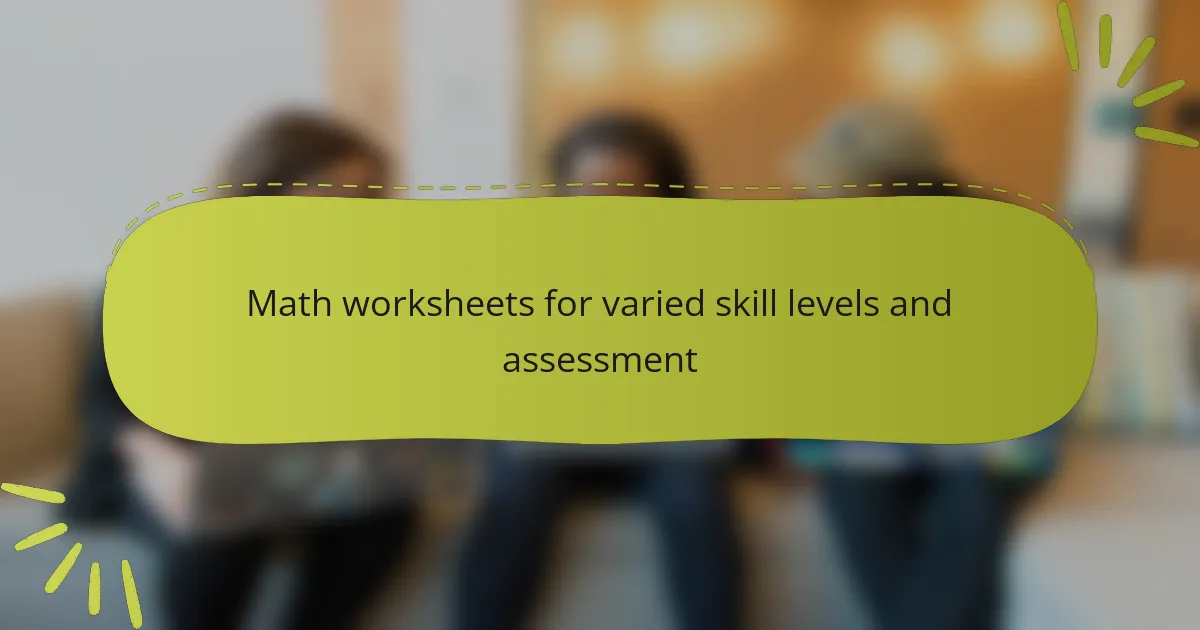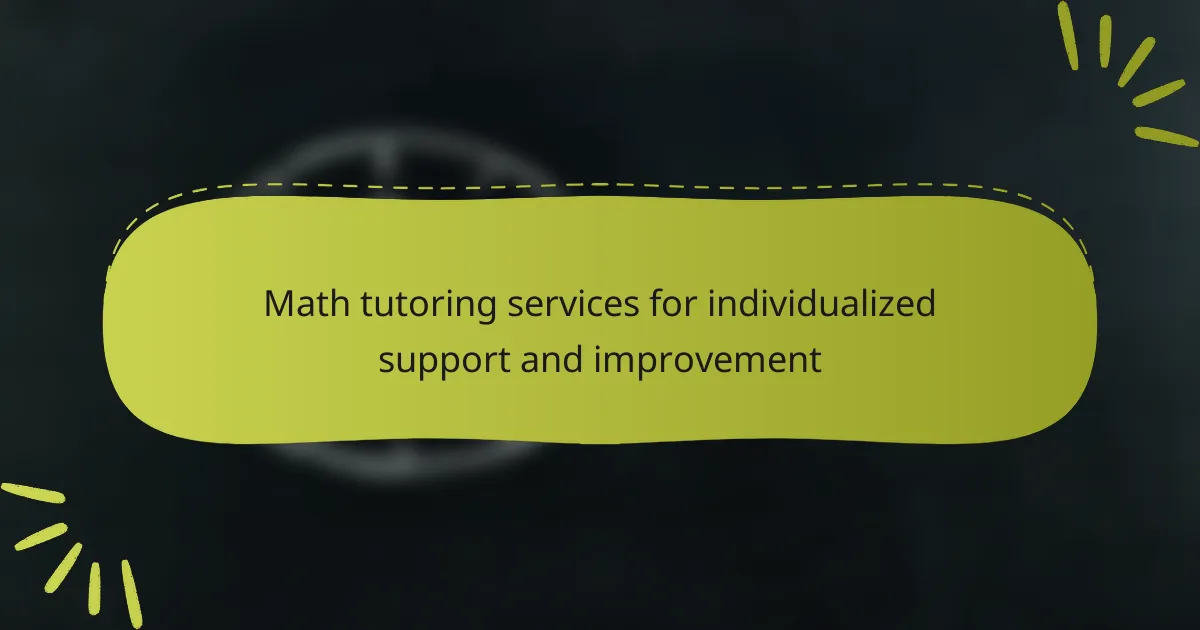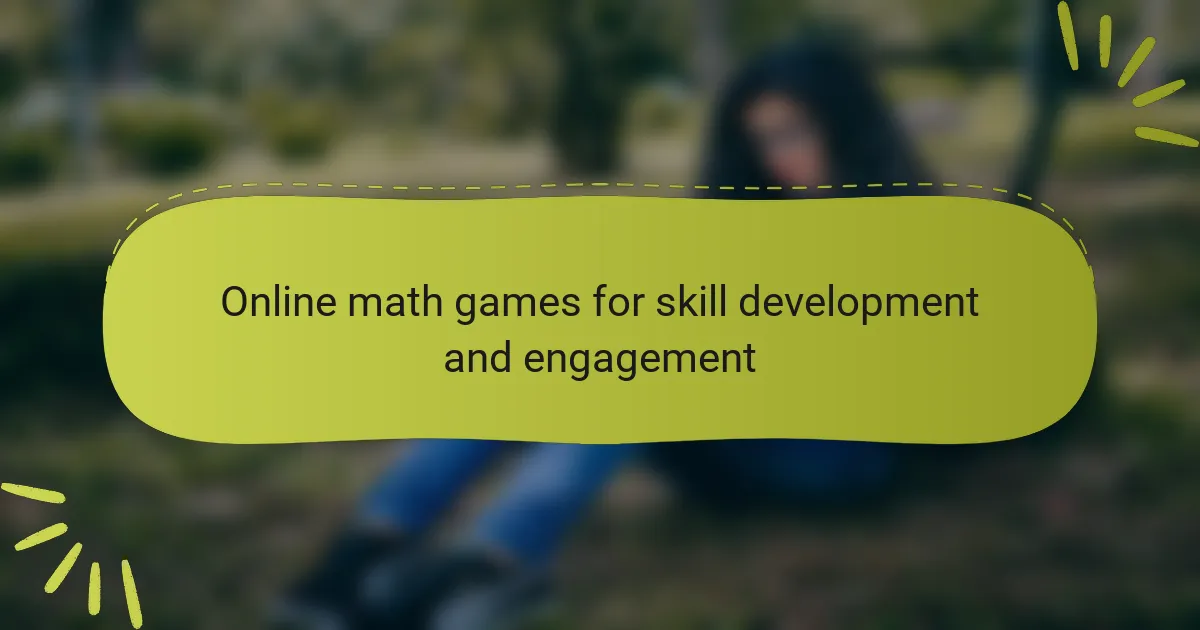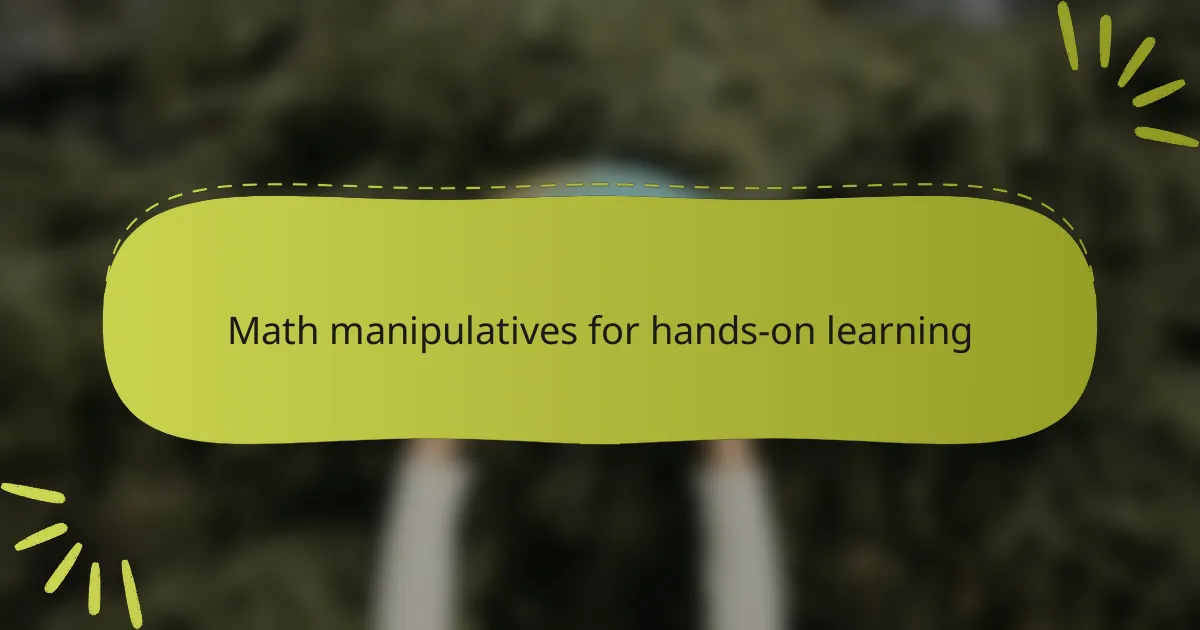Math resources for special education and inclusive practices encompass tools, strategies, and materials specifically designed to support diverse learners in enhancing their mathematical understanding. These resources include manipulatives such as counting blocks, visual aids like charts, and digital tools such as interactive math software that provide personalized learning experiences. Additionally, specialized curricula cater to individual learning styles and paces, while professional development for educators emphasizes inclusive teaching strategies. Research shows that the effective use of these resources significantly improves engagement and achievement in mathematics for all students.
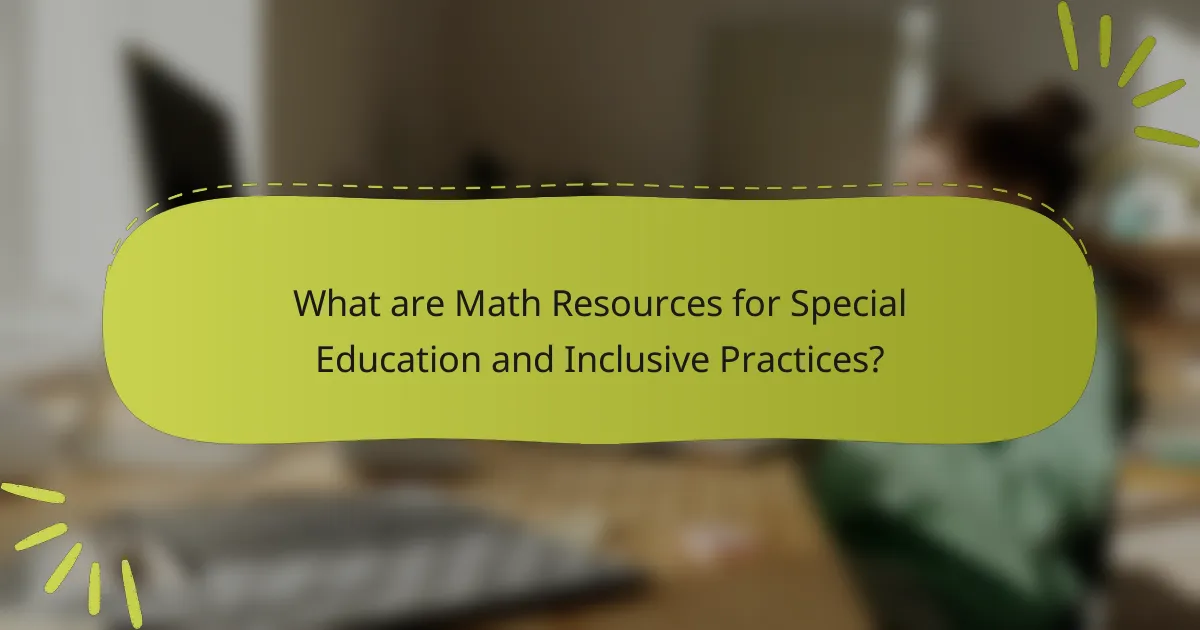
What are Math Resources for Special Education and Inclusive Practices?
Math resources for special education and inclusive practices include tools, strategies, and materials designed to support diverse learners. These resources aim to enhance mathematical understanding for students with varying needs. Examples include manipulatives like counting blocks and visual aids such as charts. Digital tools, like interactive math software, offer personalized learning experiences. Specialized curricula address individual learning styles and pace. Professional development for educators focuses on inclusive teaching strategies. Research indicates that using these resources improves engagement and achievement in math for all students.
How can math resources support special education?
Math resources can support special education by providing tailored instructional materials. These resources include manipulatives, visual aids, and technology-based tools. They help students with diverse learning needs grasp mathematical concepts. For example, manipulatives allow hands-on learning, which can enhance understanding. Visual aids support students who benefit from graphical representations. Technology tools, like educational software, offer interactive experiences. Research shows that such resources improve engagement and retention. A study by the National Center for Learning Disabilities highlights the effectiveness of specialized math resources in enhancing learning outcomes for students with disabilities.
What types of math resources are most effective for special education?
Visual aids, manipulatives, and interactive software are the most effective math resources for special education. Visual aids include charts and graphs that help students understand concepts. Manipulatives, such as blocks or counters, allow hands-on learning. Interactive software engages students through games and activities tailored to their needs. Research shows that these resources improve comprehension and retention for students with learning disabilities. A study by the National Center for Learning Disabilities found that multi-sensory approaches significantly enhance learning outcomes. These methods cater to diverse learning styles, making math more accessible and enjoyable.
How do these resources cater to different learning needs?
Math resources for special education and inclusive practices cater to different learning needs by providing varied instructional strategies. These resources include visual aids, manipulatives, and technology tools. Visual aids help students grasp abstract concepts through concrete representation. Manipulatives allow hands-on exploration, enhancing understanding through tactile learning. Technology tools offer interactive experiences that can be customized to individual learning paces. Additionally, differentiated instruction strategies enable educators to tailor lessons based on student abilities. Research shows that using multiple modalities improves engagement and retention in diverse learners. Therefore, these resources effectively address the diverse needs within special education settings.
Why are inclusive practices important in math education?
Inclusive practices are important in math education because they ensure all students have equal access to learning. These practices foster a supportive environment that accommodates diverse learning needs. Research shows that inclusive classrooms improve academic outcomes for all students. For instance, a study by the National Center for Learning Disabilities found that inclusive education enhances engagement and participation. Furthermore, inclusive practices promote collaboration among students, which builds social skills and confidence. By addressing varied learning styles, teachers can tailor instruction effectively. This approach ultimately leads to a more equitable educational experience.
What are the key principles of inclusive practices in math?
The key principles of inclusive practices in math are accessibility, differentiation, and collaboration. Accessibility ensures that all students can engage with mathematical content. This includes using varied teaching methods and materials tailored to diverse learning needs. Differentiation involves modifying instruction to meet individual student requirements. Teachers assess students’ strengths and weaknesses to provide appropriate challenges. Collaboration emphasizes teamwork among educators, specialists, and families. This approach fosters a supportive learning environment. Research shows that inclusive practices enhance student engagement and achievement in mathematics. Studies indicate that students in inclusive settings perform better academically and socially.
How do inclusive practices enhance learning outcomes for all students?
Inclusive practices enhance learning outcomes for all students by creating an equitable learning environment. These practices address diverse learning needs. They promote engagement and participation among all students. Research shows that inclusive classrooms improve academic performance. A study by the National Center for Learning Disabilities found that students in inclusive settings score higher in math. Furthermore, inclusive practices foster social skills and collaboration. This environment encourages peer support and interaction. Ultimately, all students benefit from a rich, diverse learning experience.
What challenges do educators face in implementing math resources?
Educators face several challenges in implementing math resources for special education and inclusive practices. One significant challenge is the lack of training in specialized instructional strategies. Many educators are not adequately prepared to use differentiated approaches for diverse learners. Another challenge is the limited availability of appropriate resources that cater to varying learning needs. This scarcity can hinder the effectiveness of math instruction. Additionally, educators often encounter resistance from students who struggle with math concepts. This resistance can lead to decreased motivation and engagement. Furthermore, time constraints in the curriculum can limit the opportunity for educators to effectively implement these resources. Lastly, inadequate support from administration can create barriers to accessing necessary materials and training.
How can educators overcome barriers to using math resources effectively?
Educators can overcome barriers to using math resources effectively by implementing targeted training and support. Professional development workshops can enhance educators’ skills in utilizing these resources. Access to collaborative planning time with colleagues can foster sharing of best practices. Incorporating technology can make math resources more engaging and accessible for all students. Providing differentiated instruction can address diverse learning needs within the classroom. Research shows that consistent use of effective math resources improves student outcomes. The National Council of Teachers of Mathematics emphasizes the importance of equitable access to quality resources.
What support systems are available for educators in special education?
Support systems available for educators in special education include professional development programs, mentorship, and collaborative teaching models. Professional development programs offer training on best practices for teaching students with disabilities. These programs often focus on instructional strategies and classroom management techniques. Mentorship provides new special education teachers with guidance from experienced educators. This support fosters confidence and skill development. Collaborative teaching models involve partnerships between general and special education teachers. This approach enhances resource sharing and instructional support. Additionally, access to specialized resources and tools, such as assistive technology, is crucial. These systems collectively improve the educational experience for both educators and students.
How can technology enhance math resources for special education?
Technology can enhance math resources for special education by providing personalized learning experiences. Adaptive software can tailor lessons to individual student needs. Visual aids like interactive apps can help illustrate complex concepts. Online platforms offer access to a variety of resources and tools. These resources can include games, videos, and quizzes that engage students. Assistive devices can support students with disabilities in completing math tasks. Research shows that technology improves student engagement and understanding. For example, a study by the National Center for Learning Disabilities found that technology integration leads to better academic outcomes for students with learning disabilities.
What specific tools and applications are beneficial for students with disabilities?
Assistive technology tools and applications are beneficial for students with disabilities. These tools enhance learning experiences and improve accessibility. Examples include speech-to-text software, which helps students with writing difficulties. Text-to-speech applications assist those with reading challenges by converting written text into spoken words. Visual aids, such as graphic organizers, support students in organizing their thoughts and ideas. Math-specific tools like virtual manipulatives allow hands-on learning for students with physical disabilities. Additionally, software like ModMath provides a platform for students to complete math assignments digitally. Research indicates that these tools can significantly improve academic performance for students with disabilities.
How does technology facilitate personalized learning in math?
Technology facilitates personalized learning in math by providing tailored educational experiences. Adaptive learning platforms adjust content based on individual student performance. These platforms analyze data to identify strengths and weaknesses. They offer customized practice problems that match each learner’s pace. Additionally, interactive software engages students through gamification. This approach enhances motivation and retention of mathematical concepts. Tools like virtual manipulatives allow hands-on exploration of abstract ideas. Research shows that technology can improve student outcomes in math by 30%. Overall, technology personalizes math education effectively for diverse learners.
What are best practices for selecting math resources for diverse learners?
Best practices for selecting math resources for diverse learners include ensuring accessibility, cultural relevance, and adaptability. Accessibility means that resources should cater to various learning styles and disabilities. Cultural relevance ensures that materials reflect the backgrounds and experiences of all students. Adaptability allows teachers to modify resources to meet individual needs. Research shows that inclusive resources improve engagement and learning outcomes. For example, studies indicate that culturally responsive teaching enhances student participation. Using a variety of formats, such as visual aids and manipulatives, supports different learning preferences. Collaborating with special education professionals can also guide resource selection effectively.
How can educators assess the effectiveness of math resources in their classrooms?
Educators can assess the effectiveness of math resources by evaluating student performance and engagement. They should analyze test scores before and after resource implementation. Observations during math activities can provide insight into student engagement. Feedback from students regarding the resources can highlight areas of improvement. Additionally, comparing outcomes with established benchmarks can indicate success. Research shows that effective resources align with students’ individual learning needs. Studies indicate that tailored resources improve student understanding and retention in math.
What criteria should be used to evaluate math resources for inclusivity?
Criteria to evaluate math resources for inclusivity include accessibility, representation, adaptability, and cultural relevance. Accessibility ensures that resources are usable by individuals with diverse needs. This includes considerations for visual, auditory, and physical accessibility. Representation involves the inclusion of diverse perspectives and examples that reflect various backgrounds and experiences. Adaptability allows educators to modify resources to meet the specific needs of all learners. Cultural relevance ensures that the content is meaningful and relatable to students from different cultural contexts. These criteria help create an equitable learning environment, facilitating engagement and understanding for all students.
What strategies can educators use to implement math resources effectively?
Educators can implement math resources effectively by integrating differentiated instruction tailored to diverse learning needs. This approach allows teachers to adapt materials according to students’ varying abilities and learning styles. Additionally, utilizing hands-on manipulatives can enhance understanding through tactile learning experiences. Incorporating technology, such as educational software and apps, engages students and provides interactive learning opportunities. Collaborating with special education professionals ensures that resources meet all students’ unique requirements. Regularly assessing students’ progress helps educators adjust strategies and resources as needed. Research indicates that these methods improve student engagement and achievement in math.
How can collaborative teaching enhance the use of math resources?
Collaborative teaching enhances the use of math resources by fostering shared expertise among educators. This approach allows teachers to combine their strengths and knowledge. As a result, they can provide more diverse and effective math resources. Collaborative teaching encourages the integration of different teaching styles. This leads to a more engaging learning environment for students. Research indicates that collaboration can improve student outcomes. For instance, a study by Friend and Cook (2010) highlights that co-teaching models increase resource utilization. These models enhance instructional strategies and cater to diverse learning needs. Therefore, collaborative teaching is crucial for maximizing math resource effectiveness in special education and inclusive practices.
What are some practical tips for integrating math resources into lesson plans?
Incorporate hands-on activities to engage students with math concepts. Use manipulatives like blocks or counters to visualize problems. Integrate technology by utilizing educational apps that cater to diverse learning styles. Provide visual aids such as charts and diagrams to support understanding. Differentiate instruction by offering varied resources for different skill levels. Collaborate with special education professionals to tailor resources for individual needs. Use real-world examples to make math relevant and relatable. Regularly assess understanding and adjust resources as necessary for continuous improvement.
How can educators measure the impact of math resources on student learning?
Educators can measure the impact of math resources on student learning through assessments and observations. Standardized tests can provide quantifiable data on student performance. Formative assessments, such as quizzes and assignments, can track progress over time. Educators can also use observational methods to assess student engagement and understanding during lessons. Data analysis from these assessments helps identify trends in learning outcomes. Comparing pre- and post-resource implementation scores offers insights into effectiveness. Additionally, feedback from students and parents can inform the impact of resources. Research indicates that targeted math interventions significantly improve student achievement, highlighting the importance of effective resource utilization.
What assessment methods are effective for evaluating student progress in math?
Formative assessments are effective for evaluating student progress in math. These assessments include quizzes, observations, and class discussions. They provide immediate feedback to both teachers and students. Summative assessments, such as standardized tests, also measure student understanding. Performance tasks assess students’ ability to apply math concepts in real-world situations. Portfolio assessments showcase a student’s work over time. Peer assessments encourage collaboration and reflection among students. Research shows that varied assessment methods lead to a more comprehensive understanding of student progress.
How can feedback from students guide the use of math resources?
Feedback from students can significantly guide the use of math resources. It allows educators to understand student preferences and challenges. By collecting feedback, teachers can identify which resources are effective and which are not. This information helps in tailoring instruction to meet diverse learning needs. Additionally, student feedback can highlight gaps in resources. For example, students may express a need for more visual aids or interactive tools. Addressing these needs can enhance engagement and comprehension. Research shows that student input leads to improved educational outcomes. A study by Hattie (2009) emphasizes that feedback is crucial for student achievement in learning environments.
What are the key takeaways for utilizing math resources in special education?
Key takeaways for utilizing math resources in special education include personalized learning approaches. These resources should cater to diverse learning styles and needs. Visual aids, manipulatives, and technology can enhance understanding. Collaborative learning promotes engagement and social skills. Consistent assessment helps track progress and adjust strategies. Professional development for educators ensures effective resource implementation. Research indicates that tailored interventions improve math outcomes for students with disabilities.
How can educators stay updated on new math resources and inclusive practices?
Educators can stay updated on new math resources and inclusive practices by engaging in professional development. Attending workshops and conferences focused on math education is essential. These events often showcase the latest tools and strategies. Subscribing to educational journals and newsletters provides ongoing insights. Online platforms like Edutopia and Teachers Pay Teachers offer valuable resources. Joining professional organizations, such as the National Council of Teachers of Mathematics, keeps educators informed. Participating in online forums and social media groups fosters community sharing of best practices. Research studies, like those published in the Journal of Special Education, highlight effective strategies and resources. Engaging with these varied sources ensures educators remain current and effective in their teaching methods.
What community resources can support educators in their efforts?
Community resources that can support educators include local educational organizations, libraries, and community centers. Local educational organizations often provide training programs and workshops tailored for special education. Libraries offer access to a variety of teaching materials and resources for educators. Community centers may host events and programs that promote inclusive practices in education. Additionally, online platforms like Teachers Pay Teachers provide resources created by educators for educators. Research shows that collaboration with community resources can enhance teaching effectiveness and student outcomes in special education.
Math resources for special education and inclusive practices encompass various tools, strategies, and materials aimed at enhancing mathematical understanding for diverse learners. These resources include manipulatives, visual aids, and technology-based tools that cater to individual learning needs and styles. The article discusses the effectiveness of these resources in improving engagement and academic outcomes, the importance of inclusive practices in fostering equitable learning environments, and the challenges educators face in implementing these resources. Additionally, it highlights best practices for selecting and assessing math resources, as well as the role of technology in personalizing learning experiences for students with disabilities.
